June 2025 News

While the workings of Class BB 67400 are regularly reported, the older BB 67200 tend to be overlooked. On 6 May BB 67280 that entered service as BB 67068 in December 1965 and now sporting LED headlights (see item below), passes through La Meux La Croix-St-Ouen with ballast from Tergnier to the LGV depot at Longueil-Ste-Marie. Photo: Jean-Louis Poggi.
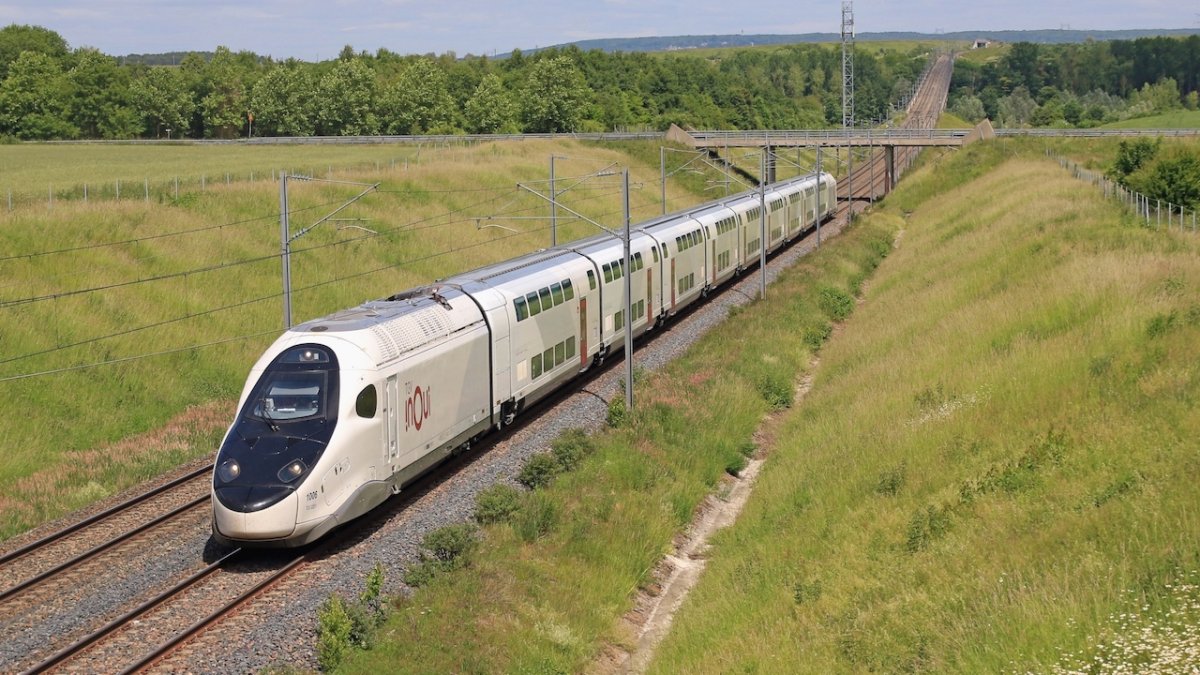
TGV Inoui 1006 is the latest of the production series to enter service and since the end of April has been participating in the endurance testing for the class to cover one million kilomètres before entering commercial service. On 29 May it undertook three return journeys on LGV Est, seen above at Claye-Souilly returning from Champagne-Ardenne to Pantin, before embarking on its final trip of the day to Strasbourg.
Photo: Christophe Masse.

Ouigo Tango TGV set 734 leads Dayse set 795 on Train 7875 Paris to Montpellier Sud-de-France at Chevry-Cossigny on 27 April.Set 734 is made up of the automotrices from POS 4403 coupled with the coaches from Reseau Duplex set 607, increasing seating capacity from 634 to 656. Photo: Christophe Masse.
Ouigo expansion plans
To accommodate the increased services, the current Ouigo fleet of 38 high-density Dayse TGVs will be augmented by transfer of 12 sets from the Inoui fleet. A €600 million programme underway for completion by 2028 will see 40 of the sets refurbished to the Ouigo Tango standard, with power cars receiving a mid-life overhaul and a redesign of the coaches. This will include increasing capacity from 634 seats to 653-656, more luggage space and room for eight bicycles. The other 10 sets are scheduled for withdrawal by 2032; although their power cars will receive the mid-life overhaul, the coach interiors will just receive a modest refresh retaining their current seats and fittings.
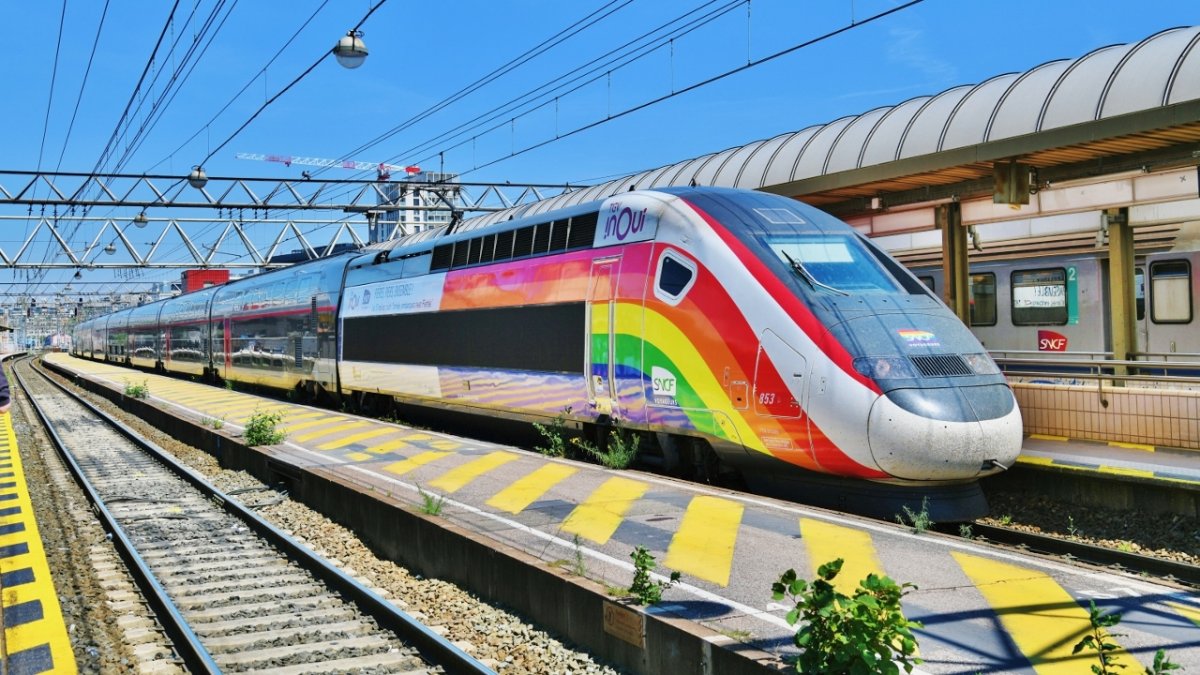
Sparkling in the midday sun at Lyon Part-Dieu on 15 May, Euroduplex l’Océane Set 853 proudly sports new Rainbow livery. No stranger to special colours, on commissioning in 2016 Set 853 appeared with 852 in vinyls created by local artists evoking the people and colours of Occitanie and Nouvelle-Atlantique régions. Photo: Pierre Julien.
Ambition France Transports
The Ambition France Transports commission was inaugurated at Marseille on 5 May by prime minister François Bayrou. Amongst other aims, it is exploring means of providing ‘robust and sustainable’ long-term finance for rail operations, infrastructure maintenance and investment “without burdening the State” in the prime minister’s words. Headed by former transport minister Dominique Bussereau, the commission is working to a tight schedule and will report in September.
Huge sums must be found over the coming decade to finance decarbonisation of travel and freight movement, as well as for maintenance of ageing infrastructure whose decline is accelerating due to climate change. “If we want to make the ecological transition, we need more freight [on rail], more public transport, more electric lorries, and more waterways" Bussereau said. One report has suggested the need for €100 billion investment by 2030.
One of the four working groups will look at funding sources for developing SERM networks and the 7,000km of fragile dessertes fines currently under pressure as regional budgets are squeezed. Another will examine the future of motorway concessions, due to expire between 2031 and 2036, and whether road toll or tax income should be used to finance public transport, an approach favoured by the present transport minister Philippe Tabarot. Concessionaires have an annual turnover of some €13 billion. Also on the table is reimposition of the heavy goods vehicle eco-tax that sparked an outcry in 2013 before being abandoned. Had it been maintained, "we would have €6 billion more per year [to work with]" Bussereau said.
In its contribution to the commission published a week later, SNCF said that it required an additional €1 billion per year to save the network from ‘massive degradation’ by 2028, and warned of ‘daily delays, interruptions to service and collapse of quality’. It drew attention in particular to the impact of ancient electrification equipment, with half of all OHL now more than 50 years old.
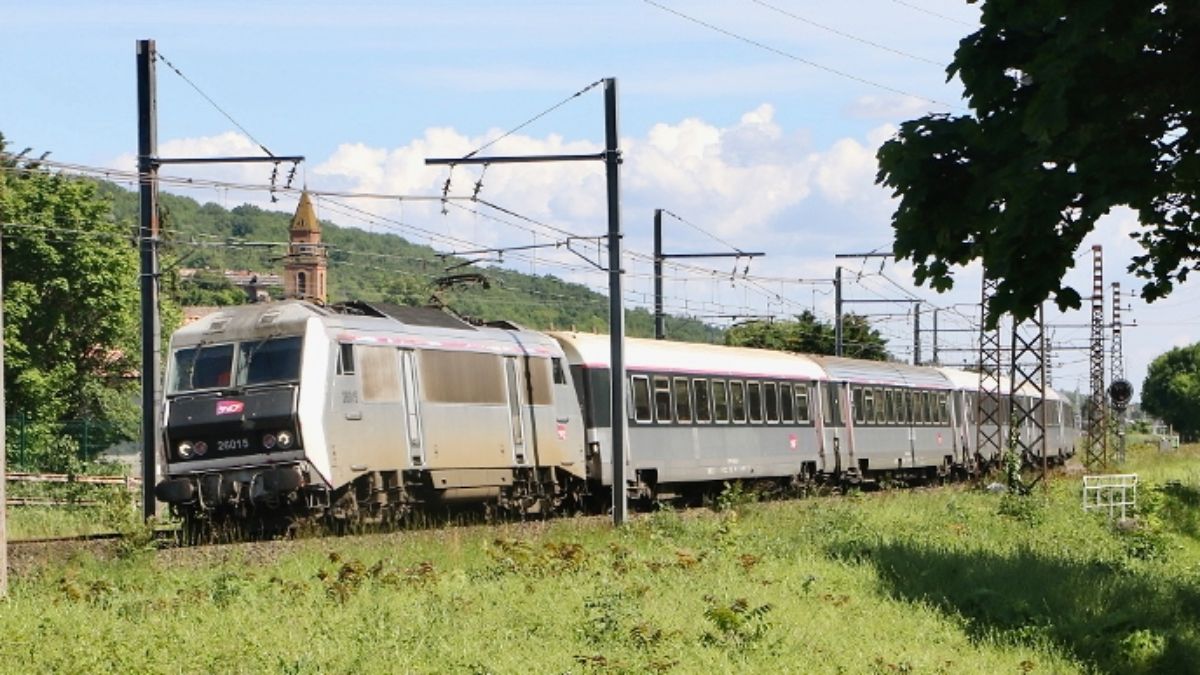
With Oxygène trainsets not expected to enter commercial service until the spring of 2027 Class BB 26000 sybics and Corail rolling stock are likely to be in operation for another two years. On 14 May a scruffy looking BB 26015 with virtually no carmillon stripes passes Pompignan soon after leaving Toulouse with Intercités 3694 16.07 to Paris-Austerlitz. Photo: Georges Turpin.
21st century train for IC
SNCF’s first Oxygène trainset was shown to the press on 24 April at Villeneuve-Saint-Georges depot southeast of Paris. Aimed at revitalising the Intercités routes to Toulouse and Clermont-Ferrand, the trains will replace 50-year-old Corail stock from spring 2027 following complete upgrading of the two classic lines. SNCF and its customers will be hoping for the start of a new era after years of delays, disruption and public disquiet over the poor service.
CAF’s 10-car aluminium-bodied articulated trains can operate under 1.5 kV DC or 25 kV 50 Hz overhead, with the two end cars and two centre cars each having two axles driven by asynchronous traction motors, giving a continuous rating of 4 MW. Maximum speed is 200km/h.
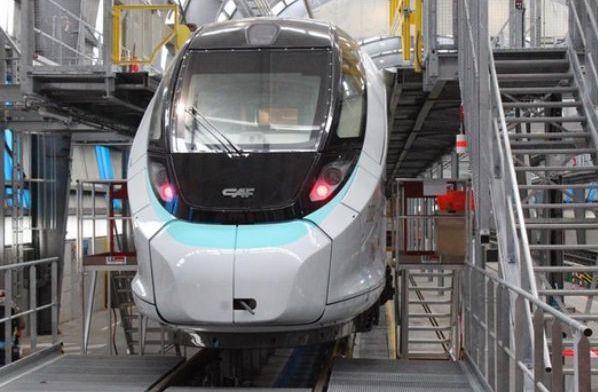
Inside, the cream fittings with red and blue seating are reminiscent of Corail interiors. Indeed, one aim was to replicate the comfort of those fine coaches whilst incorporating features standard on modern rolling stock. The three first-class coaches have 2 + 1 seating upholstered in red, with the single seats offset (as in the Coradia Liners) to allow more legroom and space for hand luggage or pc adjacent. Windows can be shaded by vertical blinds. In second class, the 2 + 2 seats are in blue fabric; all can be reclined, electrically in first and manually in second class. Tables are designed for laptops and smartphones, and all seats have two armrests and electric and USB sockets. General lighting adjusts to the time of day, and there is CCTV, aircon, wifi and passenger information screens. In both classes, some seats do not have a full window view.
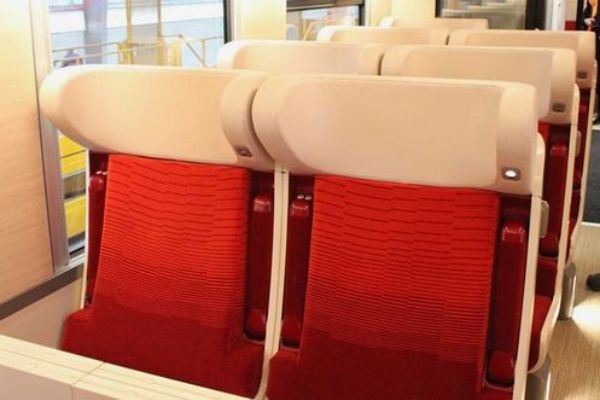
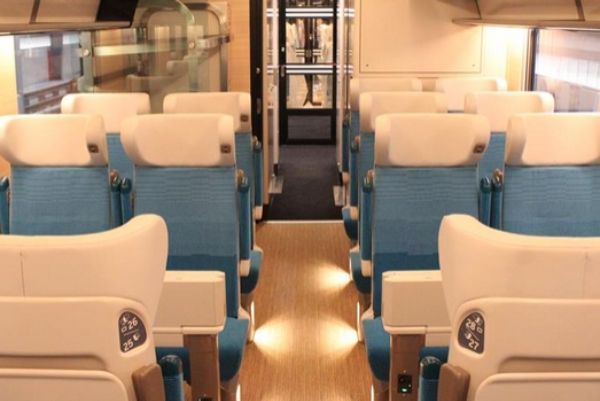
Each set has 420 seats, 103 first and 317 second class, an increase of 20 first class but a reduction overall compared to the 550 seats of a standard rake of seven Corail. Coach 4 is equipped for passengers with reduced mobility, including level barrier-free access, dedicated seats and accessible toilet (the train cannot run if this is out of service). For the first time, PMR passengers and their companions will be able to choose the extra comfort of a first-class space. Coach 5 has staff accommodation and catering facilities capable of providing restauration de qualité according to SNCF (though unspecified). There is space for 10 bikes.
Fifty of the trains designated Z 26700 are under construction by CAF; 28 were ordered in 2019 for Paris – Orléans – Limoges – Toulouse (16) and Paris – Clermont-Ferrand (12). An option for another 22 sets was exercised last year for Bordeaux – Toulouse – Marseille. Options remain for a further 25 sets which could be deployed on other routes, with Nancy – Lyon mentioned as a possibility. The first trains were originally scheduled to be in service this year but covid delays and traction motor and braking problems have pushed introduction back to 2027.
The initial order represents an investment of €1.35 billion by the State, plus €100 million for maintenance facilities in the Paris area at Villeneuve-Saint-Georges (for Clermont line trains) and Masséna (POLT trains), and for overnight servicing at Brive and Clermont. A further €1.6 billion has been spent over 10 years to modernise the infrastructure.
Two trains are undergoing 15 months’ homologation trials on the Velim text track in the Czech Republic, while a third is at Villeneuve-Saint-Georges where maintenance planning is underway. A fourth set is to be delivered shortly; this will undergo extensive dynamic trials on the two routes after which it is hoped that certification can be granted by December 2026. CAF says that 18 sets will be available for the start of service in March 2027. SNCF is touting a 15min time-saving between Paris and Limoges, and 10min to Clermont. For Limoges with up to five stops in perhaps 3h 10 this represents a hardly-exciting 126km/h. Sixty years ago, Le Capitole ran non-stop to Limoges in 2h 50.
Photos: Jérémie Anne.
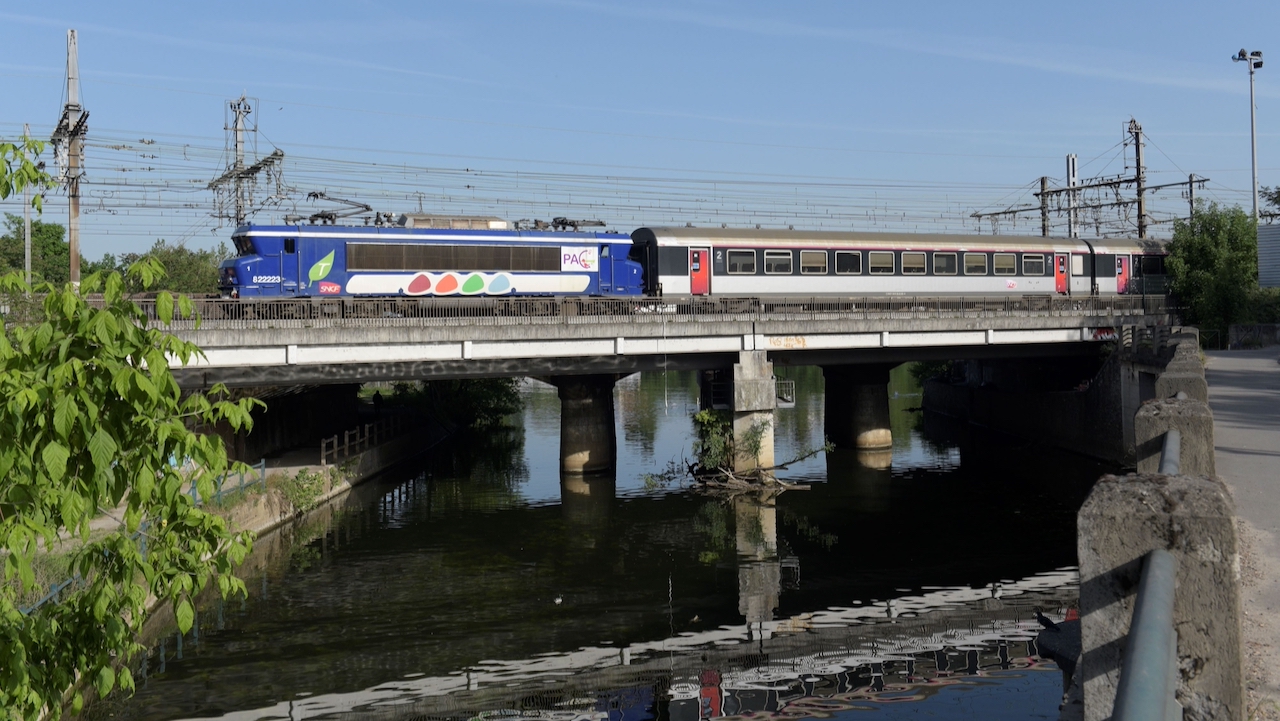
Traction problems on Paris – Clermont-Ferrand services continue. On 2 May Île-de-France Mobilities BB 22223, normally used for Transilien lignes D/R stock movements was pressed into service, seen crossing the Yerres at Villeneuve-St-Georges with Intercité 5955 09.00 Paris Bercy – Clermont-Ferrand. Photo: Jean-Louis Poggi.
The media have been questioning why SNCF is auctioning redundant Class BB 27300s, introduced between 2006-10, given the locomotive reliability problems on Paris to Clermont-Ferrand/Toulouse services. The probable reason is the BB 27300’s top speed of only 140km/h, compared to the 200km/h of BB 26000s.
Transdev ready to roll
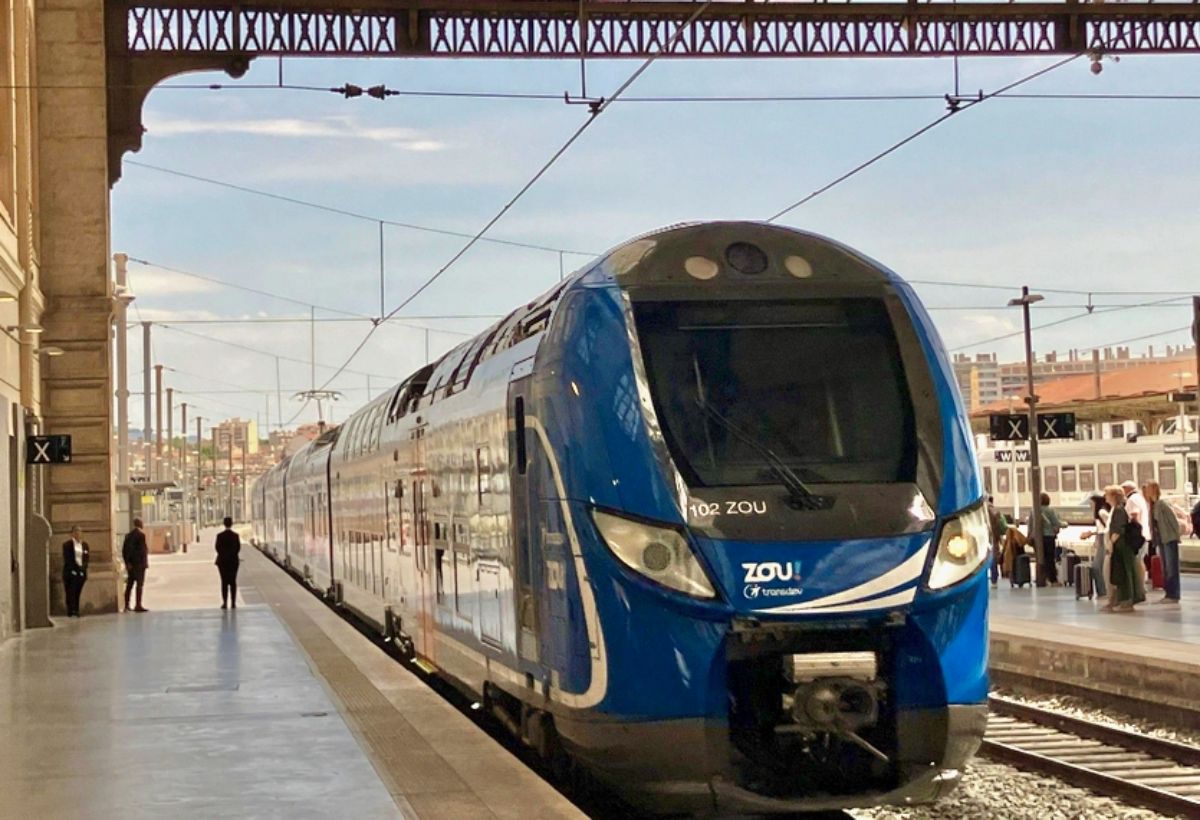
The new trains were shown to the public for the first time on 19 May at Marseille Saint-Charles, presented as the next-generation TER and a big improvement on their Corail predecessors. The eight-car double-deck Omneos have a high-quality fit-out with first and second class seating, more space for luggage and cycles (12), and light meals and refreshments available from vending machines. Customer Relations Officers will take over the role of contrôleur to provide greater onboard comfort and security. Transdev is aiming for 97% punctuality (currently 80%); Région Sud is offering a fares reduction for both occasional and regular travellers. Photo: Transdev Sud.
Strike season comes round again
In the event, the week was not as black as the unions had hoped. Nine out of 10 TGVs ran as scheduled over the holiday weekend according to SNCF, with service on Sunday 11 May being ‘almost normal’. SNCF offered passengers of cancelled trains free transfer to another within seven days, an ‘exceptional’ 50% reduction on their next journey, or reimbursement even for non-reimbursable tickets. TER and suburban trains were more severely affected. No trains ran at all in some areas on 8 May; 50% were cancelled in Île-de-France and 60% in Nouvelle-Aquitaine; by contrast turnout was low in Centre-Val de Loire and TERs there were almost entirely unaffected.
Trades unions contested SNCF’s claim that 90% of TGVs had run when up to 50% of drivers were on strike, suggesting that it had restricted the number of tickets on sale to massage the figures. This was denied, as was the accusation that TGVs had been prioritised over local trains by rostering TER staff for other duties. Nevertheless, TGV service was maintained by deployment ofvolontaires d'accompagnement occasionnel (VAO), that is office and other non-operating staff who had received seven days’ training in the role of contrôleur. Sud-Rail accused SNCF of using ‘scab mercenaries, extremely undertrained and extremely overpaid’ as strike breakers and of pitting staff against each other. VAO’s pay was reported as between €15 and €30 per hour on weekdays and €50 at weekends, said by Sud-Rail to be three to five times that of official contrôleurs. SNCF’s action escalated the dispute, with further strikes called for 4, 5 and 11 June.
MARS to survey LGV
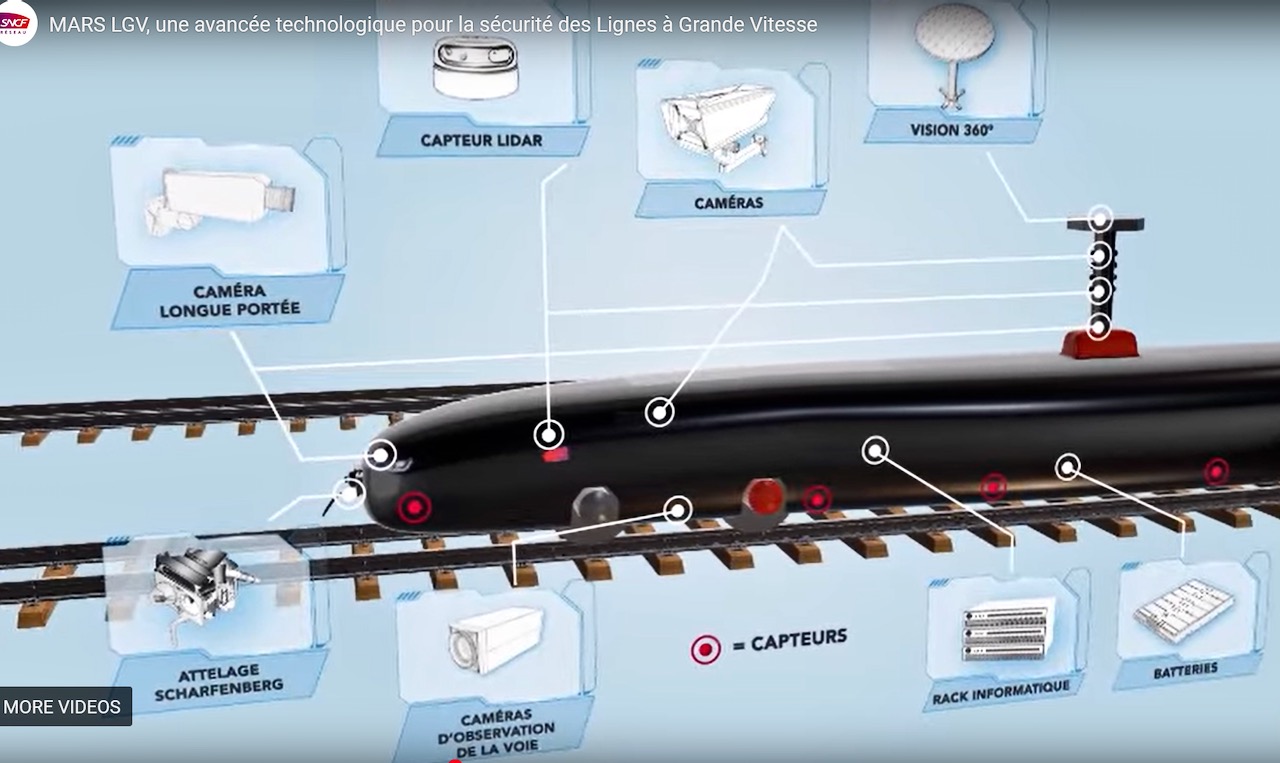
The MARS project for autonomous survey of high-speed lines has entered its development phase. Together with six partners, SNCF Réseau is working on Mobiles Autonomes de Reconnaissance en Sécurité, a digital system under which driverless battery-powered mobiles equipped with sensors will replace early-morning empty runs by TGVs to verify that lines are clear for safe high-speed operation. There are around 20 passes daily, tying-up trains which might otherwise be in service and costing € several million a year.
From 2030, SNCF intends this safety task to be entirely automated. Mobiles will be remotely supervised from an operations centre that will receive real-time information on the state of the track from on-board sensors, cameras, radar and lidar. Powered by next-generation batteries, the mobiles will run over the entire LGV network before the start of service and instantly pass information to supervisors. They will be able to detect obstacles on the track, anomalies in the infrastructure and overhead, and rapidly identify areas requiring intervention. Operation will be in GoA4 mode (Grade of Automation Level 4, no staff onboard), running at up to 230km/h.
Design is underway this year, with delivery of a prototype scheduled for 2027, field trials in 2028-29 and validation by mid-2029. MARS is also intended to provide technological ‘building blocks’ with which autonomous operation might be extended to freight trains and to depot/positioning movements of passenger stock. In a separate project with Alstom and other partners, SNCF has been testing a driverless TER multiple-unit since 2021. Image: SNCF.
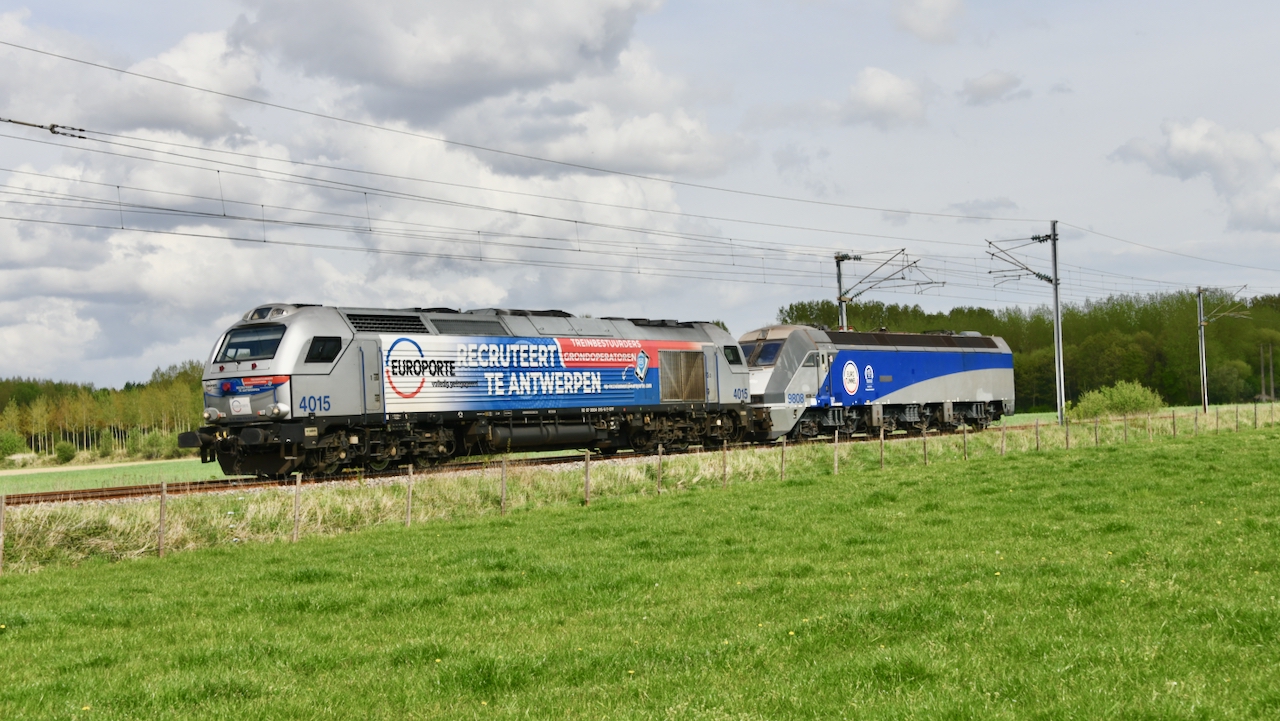
During April Eurotunnel BBB 9808 visited Valenciennes Technicentre for attention, seen above returning to Calais on the 22 April at Tressin, east of Lille, hauled by Europorte E4015 running as 47805 Valenciennes – Calais. Photo: Didier Delattre.
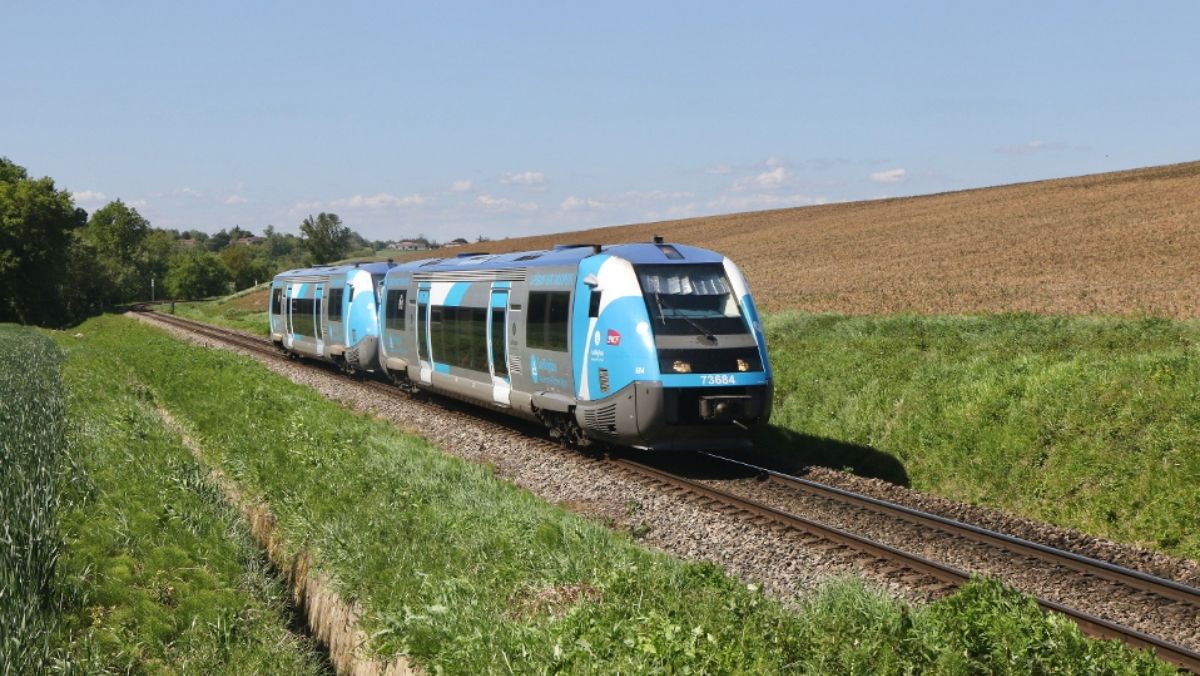
Société publique locale progress
As part of opening up the TER market to competitive tendering, régions are creating SPLs (société publique locale) that will own their rolling stock, lease it to operators and finance new procurement. AURA’s SPL, known as Actifs ferroviaires et appui à la mobilité (ARAM), was officially launched in March. It will purchase the AURA fleet apart from Corail coaches and Class BB 22200 locomotives. Above, a pair of AURA X 73500s (X 73684/73690) are seen north of Montastruc-la-Conseillère with TER 871209 10.38 Clermont-Ferrand – Toulouse.
Having taken over the greater part of the Occitanie fleet last November, this month sees the remaining eight Regio 2N sets and 38 X 73500 DMUs transferred to Occitanie's SPL - Société Publique Interrégionale des Investissements en faveur des Transports (SPIIT) will refinance the stock and lease it to SNCF Voyageurs as the current operator of TER services. Below are two examples of SPIIT's AGC fleet seen between Toulouse and Saint-Sulpice. Opened in 1864, this was originally part of the PO route from Bordeaux to Toulouse via Coutras, Brive and Capdenac. Once one of the busiest single-track lines in France, much of it was double-tracked between 2011 and 2013 under the Midi-Pyrénées rail plan. Some 11km remains single in the areas each side of the tunnels and between the passing loops at Granague and Montastruc, becoming double again 2km beyond.
Below left. AGC B 81849/50 approaches Montrabé with TER 872406 13.44 Toulouse – Mazamet. Below right. AGC B 81514/13 emerges from Seilhan Tunnel with TER 871218 17.01 Toulouse – Aurillac. All photos taken on 29 April by Georges Turpin.


SNCF wins more tenders
SNCF continues to win TER contracts put out to competitive tendering. While it may appear to be 'business as usual' there are organisational changes involved. As set out above, ownership of rolling stock passes from SNCF to the sponsoring région. For each new contract, SNCF Voyageurs sets up a local operating subsidiary. Contracts generally involve increased staff productivity. While TUPE (Transfer of Undertakings - Protection of Employment Regulations) provides some protection for existing staff, the terms and conditions for new staff are less generous than in the past.
Paris Line L. The first Paris suburban route to be opened to competitive tendering, Transilien Line L from Saint-Lazare to Versailles-Rive-Droite, Saint-Nom-la-Bretèche and Cergy-le-Haut, is to remain with SNCF. Transilien SNCF Voyageurs was the successful bidder for the operating contract which starts in December 2026. Bids are being assessed for Lines J, N and U, due to be transferred to new operators on the same date.
Bourgogne-Franche-Comté. SNCF was the only candidate bidding for the région’s first group of lines to be opened to competition, Bourgogne-Ouest-Nivernais, comprising 12% of TER traffic with around 6 million annual journeys. Services include Dijon to Mâcon and Nevers – Moulins – Lyon, Chagny – Nevers, and Montchanin to Paray-le-Monial. New through trains will link Paray with Dijon and Chalon-sur-Saône and other routes will have up to five additional A/R daily. New subsidiary SNCF Voyageurs Bourgogne Ouest will open a dedicated operating centre at Nevers and provide more local train-maintenance facilities to improve reliability. Overall, there will be a 34% increase in train-km. The seven-year contract (with three-year extension option) starts in December 2026. The next lot to be offered is Paris – Dijon – Lyon.
News in brief
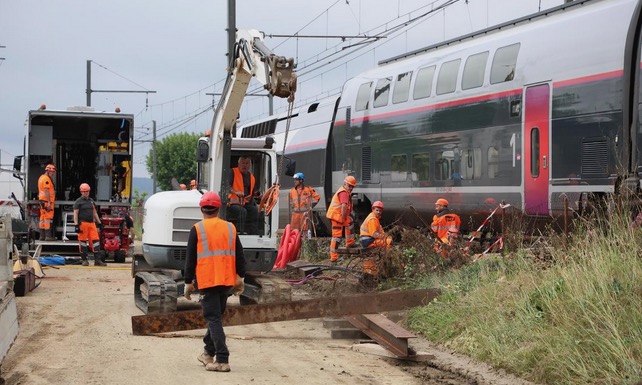

Washout at Tonneins. May was a terrible month weather-wise in the southwest with record rainfall and hail storms. On the evening of the 19th, torrential rain lashed the Bordeaux – Toulouse line at Tonneins, causing a washout and displacing the track. TGV 8517 17.05 Paris – Toulouse (Duplex Set 264) was stopped at Marmande at around 20.00 and then allowed to proceed at low speed before becoming immobilised just beyond Tonneins station where ballast had been washed away. The 508 passengers were evacuated by 23.30 and taken by bus to the local salle municipale where many of them spent the night sustained by Croix Rouge and other volunteers. Rising waters of the Garonne flooded nearby residences to a depth of more than a metre.
The following day saw the track stabilised using large timber baulks so that the train could be righted. The front power car was later detached and moved to Toulouse whilst the rest of the train was towed to Bordeaux over the night of the 21/22 May behind Infra BB 67400 No 67623. Seventy personnel of SNCF Réseau and six contractors worked round the clock to realign and reballast 200m of track. The line was partially reopened on 28 May then closed from 29 May until 1 June for scheduled engineering work. During the blockage buses operated between Agen and Marmande but were restricted to season ticket holders only, other travellers were routed via Tarbes.
Photos: SudOuest/LO.
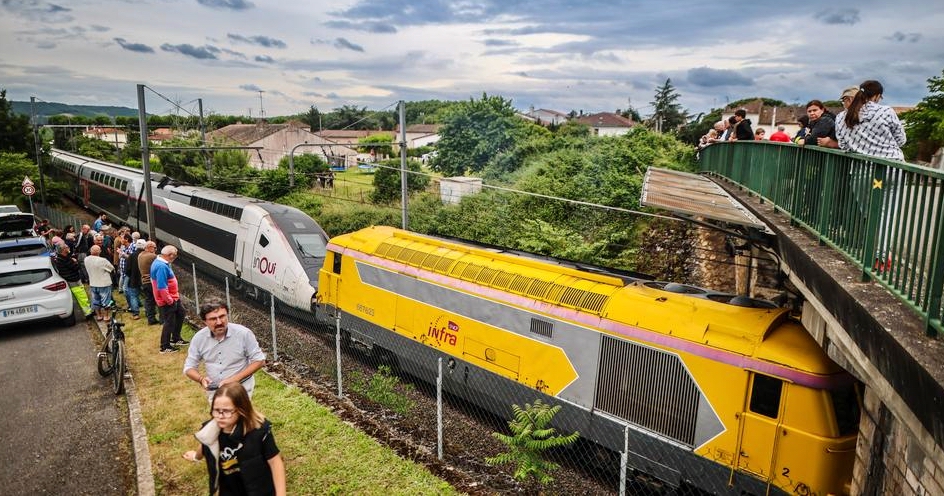
Rome – Marseille. After its poorly-patronised runs to Nice last summer, FS Treni Turistici Italiani is trying again with a Rome – Marseille Expresso Riveria night train, out Friday returning Saturday from 4 July to 30 August, calling at Genoa, Nice, Cannes and Toulon. A day train operates on Saturdays and Sundays from Milan to Ventimiglia.
Ski train again. After a two-year break, the Travelski subsidiary of Compagnie des Alpes will again run an overnight train from Paris to Bourg-Saint-Maurice using German couchettes and a bar-restaurant car chartered from Pegasus Trains. Part of CDA’s aim to provide low-carbon transport for skiers, the train will operate over 14 weekends starting on 19 December, departing Paris on Friday night and returning on Saturday night. Passengers will be offered dedicated transport from destination stations to their chosen resorts.
Bordeaux – Frankfurt. A through TGV will run again on eight Saturdays during July and August, departing Frankfurt Hbf 06.56 (TGV 9594), returning from Bordeaux at 15.57 (TGV 9599). Arrival in Frankfurt at 23.50 is hardly convenient and with 11 stops the train is clearly aimed at intermediate stations. From Bordeaux, journey time is up to an hour longer than by non-stop train to Paris and changing between Montparnasse and Gare de l’Est (though considerably cheaper).
Briançon. The night train seating accommodation is now available for local journeys between Die and Briançon, providing an earlier arrival and later departure at Briançon than by the TER service. More TERs are planned between Gap and Briançon.
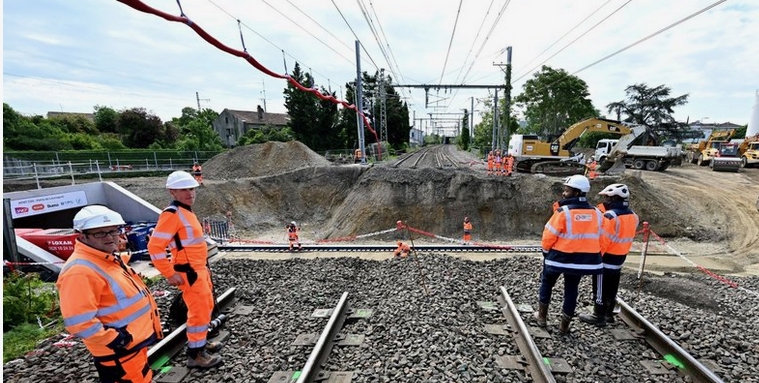
Toulouse. No trains ran to Agen from 8 to 11 May whilst a bridge deck was slid into place, part of the Toulouse – Bordeaux LGV works and in preparation for reopening the station at Route-de-Launaguet (closed 2016) which will provide interchange with metro Line C at La Vache. Two other stations are to be reopened for a local service from Castelnau-d’Estrétefonds to Toulouse every 15min starting in 2031. Photo: La Dépêche du Midi/LD.
Rocamadour. An illegal rave near Rocamadour saw rail services between Brive and Capdenac suspended by the prefecture for six days from 7 to 13 May. Over 10,000 people attended causing significant damage and disruption. Three people are in custody and €200,000 of equipment seized.
Albi. Travel between Albi-Ville and Albi-Madeleine on Toulouse – Carmaux/Rodez trains became free-of-charge for Albigeois from 1 May. A pass is required, also free, for the 4min journey across the Tarn river. The €3.5 million initial phase of redeveloping Albi-Ville as a multimodal hub has been approved, starting next year.
Pass off. Last summer’s experimental Pass Rail for youngsters will not be repeated. With sales of the €49 ticket at 235,000 against an estimate of 700,000, the transport ministry says that it cannot subsidise a scheme that failed to reach its target. The régions will continue to offer reduced TER fares for under-27s.
Pass on. Normandie région, which is revamping its school transport network for September’s rentrée, will offer an annual rail pass at €60 to encourage more youngsters to use the train to get to school.
Interlocking goes digital. France’s first digital interlocking was commissioned at Chasse-sur-Rhône south of Lyon on 24 April. Developed under the Argos programme launched in 2018, computer-based interlocking offers more efficient and reliable operation than life-expired mechanical, electro-mechanical and electrical systems.
Franco-Swiss SERM. The project was launched on 28 April when the partners agreed €1.6 million for studies to define the proposals, prepare a funding plan and develop a governance framework prior to seeking official SERM status. The plan will build on the success of the Léman Express, for which double-deck stock is expected to be ordered for delivery starting in 2030. Annecy agglomeration has committed to funding expansion of the station and reopening of that at Saint-Martin-Bellevue (see April News).
Animal crackers. Two years after the uproar following an incident at Montparnasse when a departing TGV run over and killed a passenger’s cat that had escaped, SNCF has formalised a protocol for dealing with such situations. Trains can now be delayed by up to 20min whilst searches are made.
Mont-de-Marsan. Trains were replaced by buses from 5 to 16 May whilst lineside trees were cut down following two incidents of trains hitting fallen branches. On 14 April, TER 866621 19.44 Bordeaux – Mont-de-Marsan (B 81831/32 running driver-only) hit a branch between Morcenx and Ygos. Drivers then staged a ‘go slow’, limiting speed as a precautionary measure. An similar incident at Arjuzanx on 27 April, involving TER 866652 09.02 Mont-de-Marsan – Morcenx, prompted immediate action to clear encroaching vegetation. Further work will be necessary in the autumn.
With patronage up 9% in 2024, Mont-de-Marsan is to have a new morning train next year at 08.54, returning from Bordeaux at 09.47, filling long-standing three-hour gaps. On Sundays, a Morcenx short working will be extended to Bordeaux to provide extra capacity.
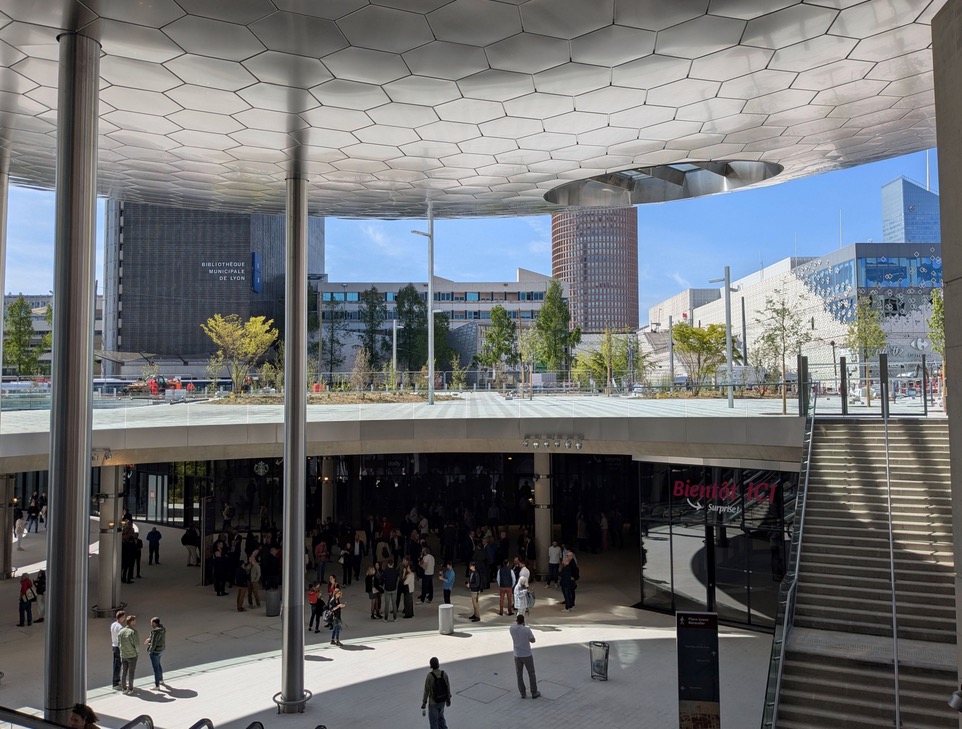
Lyon Part-Dieu. Place Béraudier, the lower entrance and public space facing boulevard Vivier-Merle, was opened in April. Beneath the steel canopy and circulating area (see August 2024 News) there is a cycle park with 1,300 spaces reached by a circular ramp, a taxi rank and passenger drop-off point, metro access and nine new green areas. Photo: mesinfos.fr/SR.
Limoges. Accessibility work and refurbishment costing €17.2 million is underway in an 18-month project to improve ambiance at platform level in advance of Oxygène’s arrival in early 2027. As well as raised platforms and new lighting, life-expired canopies and waiting areas are being replaced with modern structures. Similar work is in progress at Brive-la-Gailliarde.
Oyonnax. With €3.5 million approved for next year’s replacement of 3,500 sleepers, renovation of structures and renewal of foundations (see April News), AURA région has responded to local pressure for a better service. In December 2026, the current three A/R daily to Bourg-en-Bresse (out morning, return afternoon) will be augmented to give a more balanced timetable.
Lisea. Construction starts on 2 June at Marcheprime south of Bordeaux, site of Lisea’s €200 million train maintenance depot for new entrants to the high-speed market. Opening in 2027, the depot will have capacity for up to 20 trainsets. Lisea’s first contract is with Proxima for daily maintenance and storage of its 12 trains.
Mer de Glace. Six months after the line was taken over by Haute-Savoie département, staff went on strike accusing the new management of being ‘a bunch of amateurs’ who had failed to honour wage and conditions commitments. Trades unions are pressing for all trains to have two staff members on board following an incident on 6 March when a traction motor short-circuited and smoke poured into passenger saloons.
Mirecourt. Seventy jobs will be created at the operating and maintenance centre to be built here for the eight bioethanol MUs that will operate Nova14’s Nancy – Contrexéville line reopening in December 2027.
TGV parcels. Following a six-month trial, Amazon and Rail Logistics Europe announced on 13 May that up to 1,000 parcels per day would be carried on TGVs, two A/R daily between Lyon and Paris.
Quillan. A report published on 16 May finds that reopening the Limoux – Quillan line would meet an essential socio-economic need and could be achieved for €48 million. Commissioned by the CGT union after the project was suspended by Occitanie région last year, consultants looked at all aspects of rehabilitating the 28km line to produce costings and an assessment of the likely benefits. The project has been hotly contested, with Quillan maire Pierre Castel leading the opposition (see December 2024 News). A report already in circulation, produced at the maire’s request, presents arguments against reopening.
Nevers. The former roundhouse has been declared a Monument Historique by the Bourgogne-Franche-Comté région, thwarting efforts by SNCF to demolish the former depot. The site remains inaccessible and it is unclear who will now operate it.
Luchon. Driver training between Montréjeau and Luchon started on 21 May, running at night. Régiolis B 83529/30 was the first train to arrive at the refurbished Luchon station, at 03.00. Daytime operation began in early June for training of conducteurs prior to the inauguration on 22 June, with the full service expected to operate from the following day.
Weekday trains will leave Luchon at 06.14, 09.39, 12.42, 14.36, 17.36 and 19.36, returning at 08.12, 10.44, 13.51, 15.51, 18.51 and 20.51. The first morning train reverses at Montréjeau and runs through to Toulouse arriving at 08.20. Weekend trains run at similar times, with two Toulouse A/R. Photo: Alain Puente.
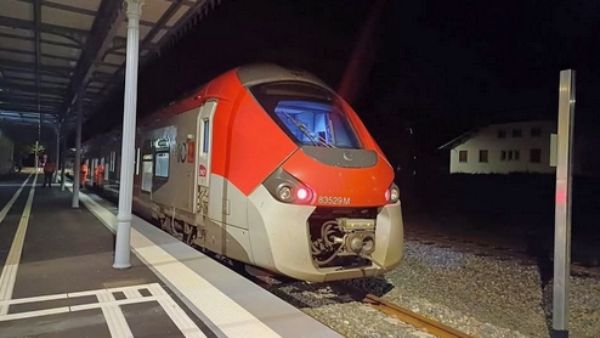
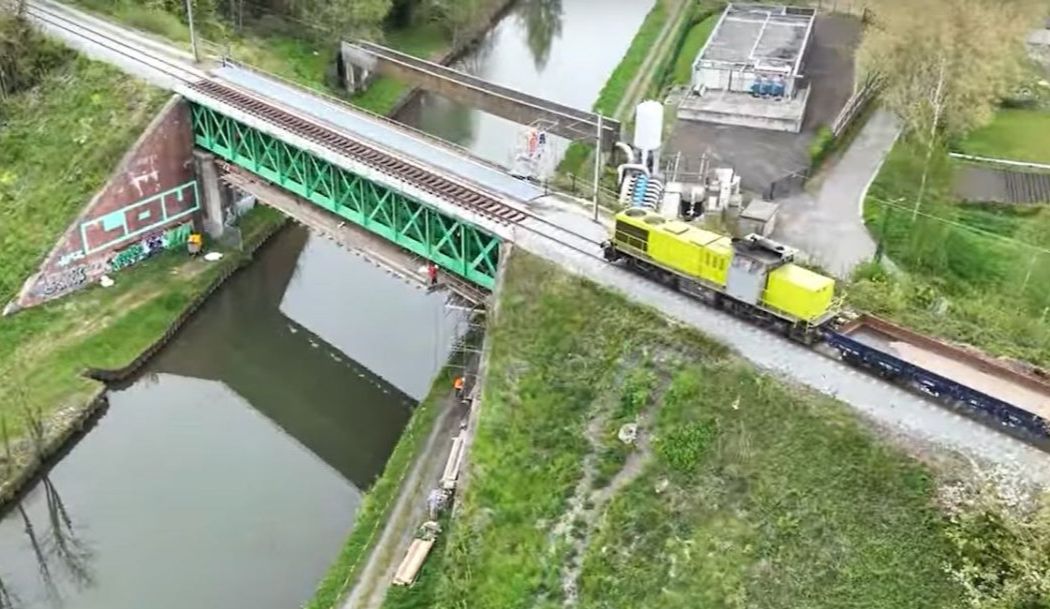
Douai – Cambrai. Trains ran again from 2 June following completion of a €78 million upgrade of the 29km electrified single track between Sin-le-Noble (Douai) and Cambrai. Begun in January 2024, the project involved renewal of 25km of track, 19 turnouts and 24 level crossings as well as replacement of two bridges and renovation of six others. Work to make Cambrai station fully accessible starts later this year. In addition to the passenger service of 8 A/R daily, the line would be capable of handling freight to the inland port at Marquion should traffic materialise. Construction of a short link from Aubigny-au-Bac to the port is under discussion. Opposite. Renovation of the Canal d’Escaut bridge at Neuville-Saint-Rémy nears completion.
Photo: SNCF Réseau.
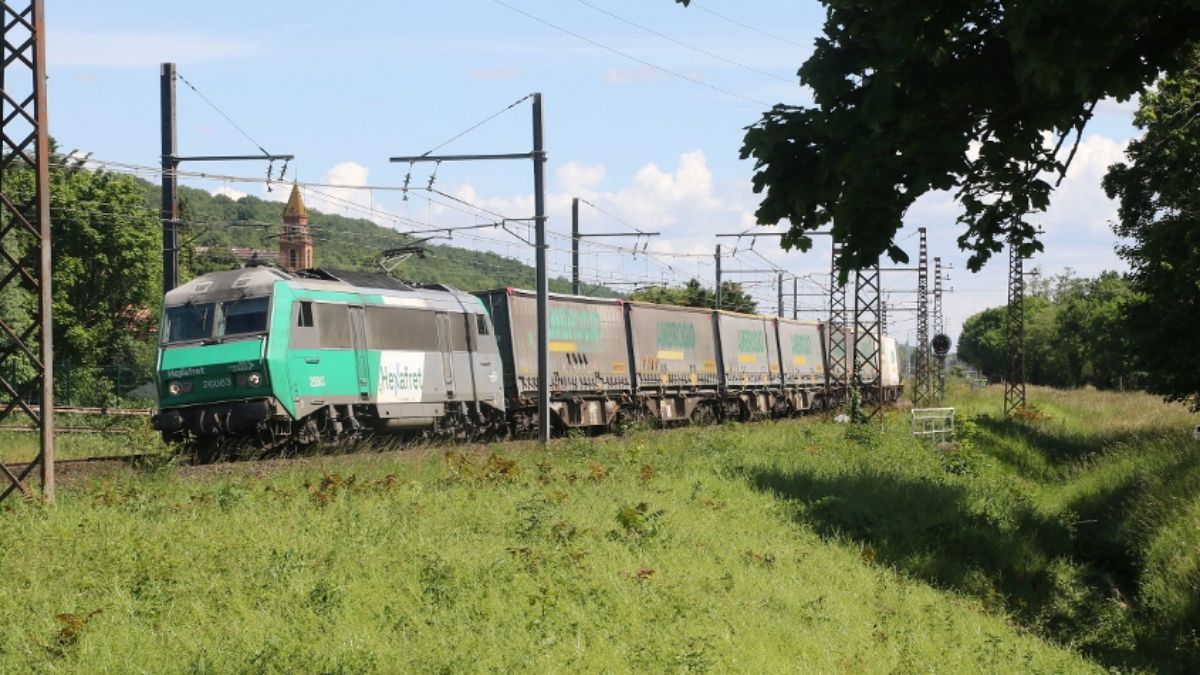
Hexafret livery appears
Formed at the beginning of the year to replace Fret SNCF, Hexafret locomotives are now starting to appear in their new livery. The changes are minimal with the old pale green, white and grey colour schemes retained and Fret SNCF replaced by Hexafret.
Above. On 14 May BB 26063 passes Pompignan, north of Toulouse, with 489870 Miramas - Hourcade 'Ambrogio' intermodal service. Photo: Georges Turpin.
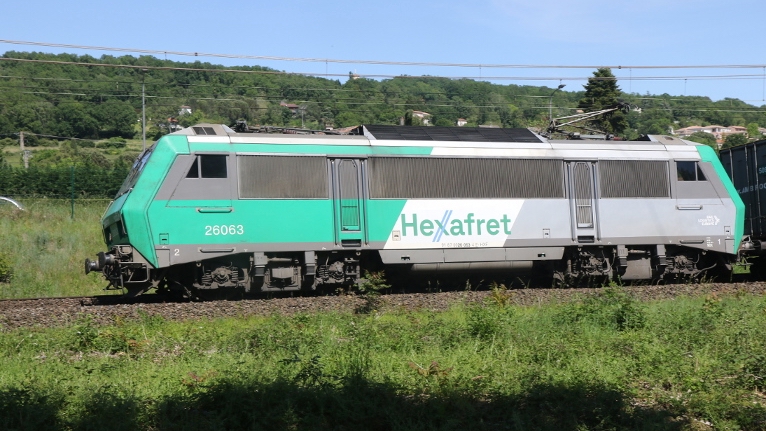
Below. On the evening of 28 May Traxx 186 193, leased by Hexafret from Akiem, passes through Valenciennes with Train 49839 Berguette-Isbergues – Châtelet (BE) diverted via Valenciennes and Jeumont instead of its normal route via Ascq and Tournai. Photo: Didier Delattre.
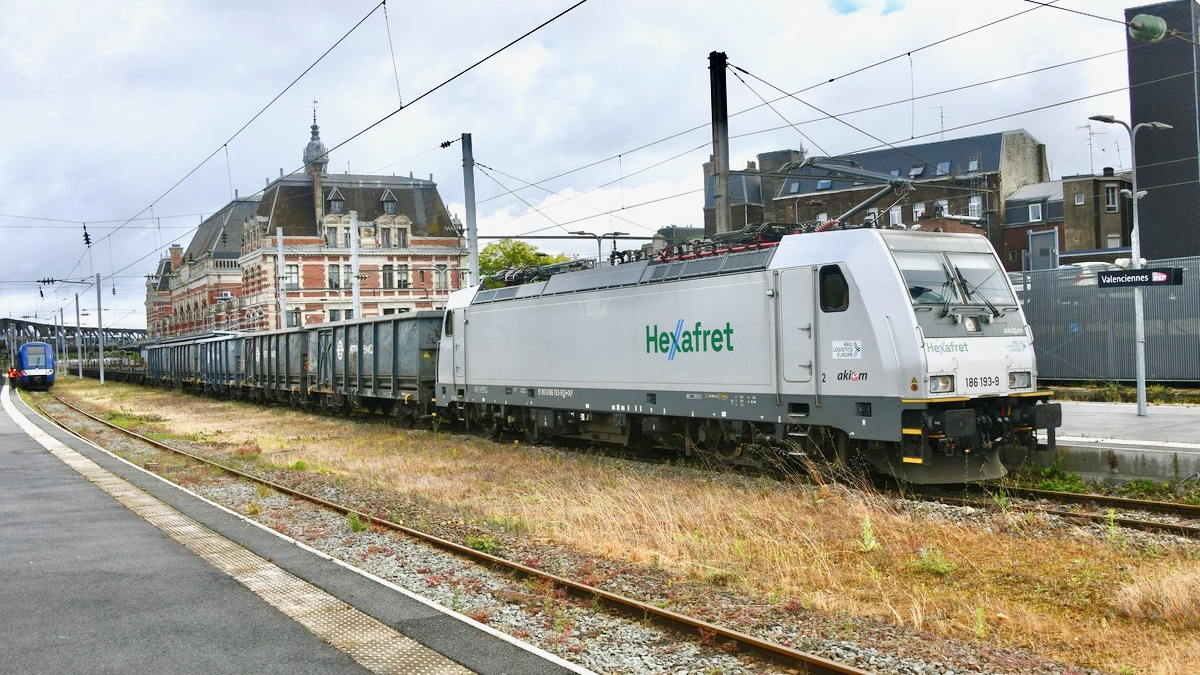
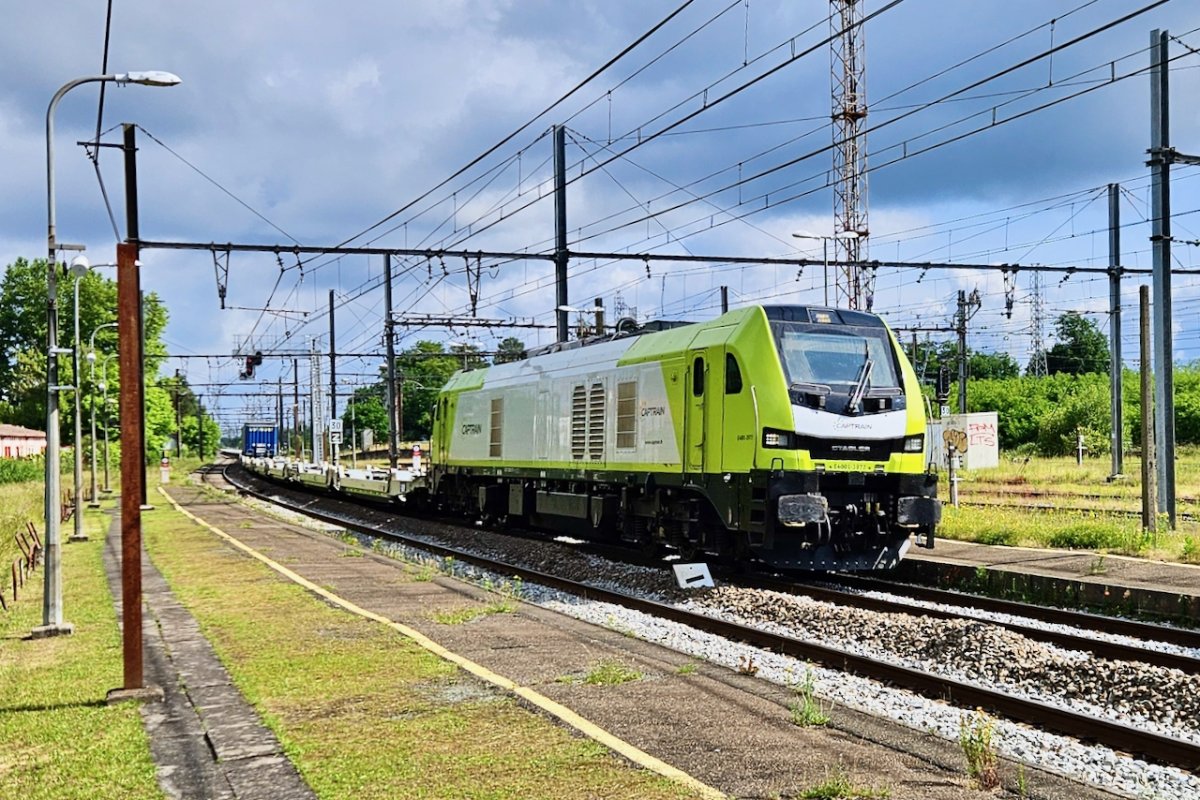
Nearing the end of its 970km journey from Cherbourg to Bayonne, the lightly-loaded first commercial working of Brittany Ferries’ferroutage (rolling motorway) piggyback service passes Morcenx at 10.35 on 21 May, Captrain Stadler E4001-3977 in charge. Currently running via Niort and Saintes, the train is diesel-powered throughout but once gauge enhancement is completed between Poitiers and Bordeaux, the southern section between Saint-Pierre-des-Corps and Bayonne could be electrically hauled. In launching the train service, Brittany Ferries will be able to realise a major economy by withdrawing a freight ferry. Two of the main customers will be Austrian logistics company LKW Walter and Spanish medical supplies company Istausi.
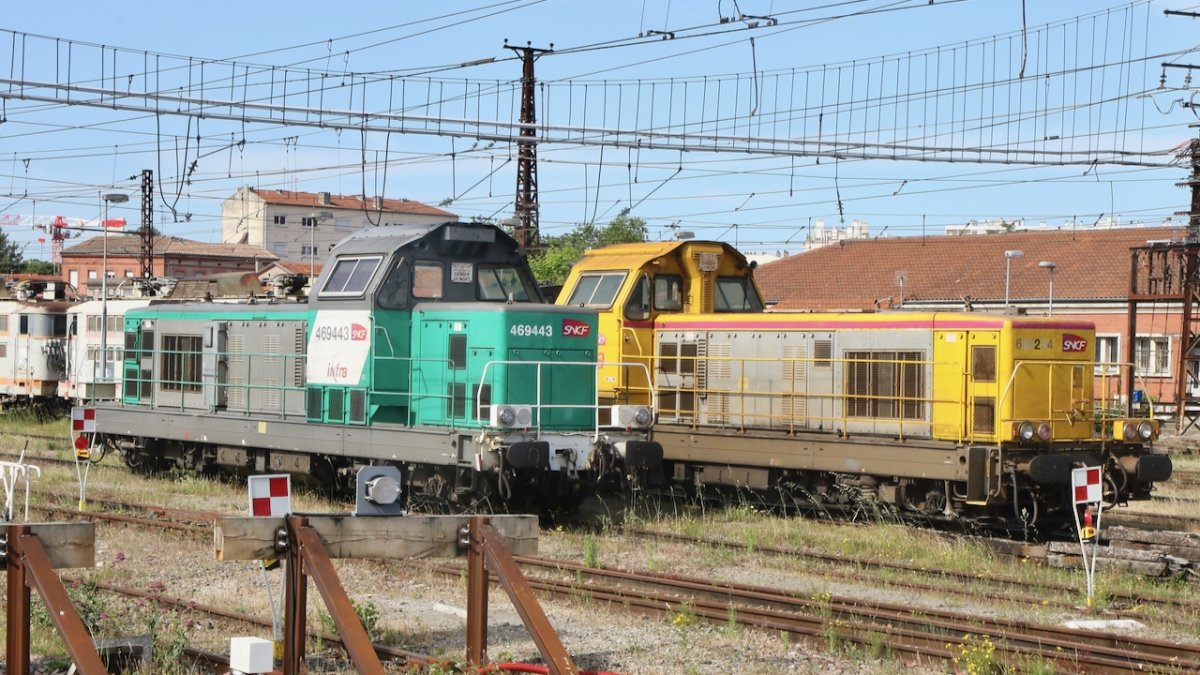
SNCF is starting to equip locomotives with LED marker lights that can emit both white and red light, replacing the existing individual white and red lights, with the former red light housing blanked off. At Toulouse on 10 May green liveried BB 69443 is seen with the new arrangemnt while yellow liveried BB 69254 retains separate white and red lights. Behind them the former snowplough locomotives CN1/2 await their fate.
Photo: Georges Turpin.
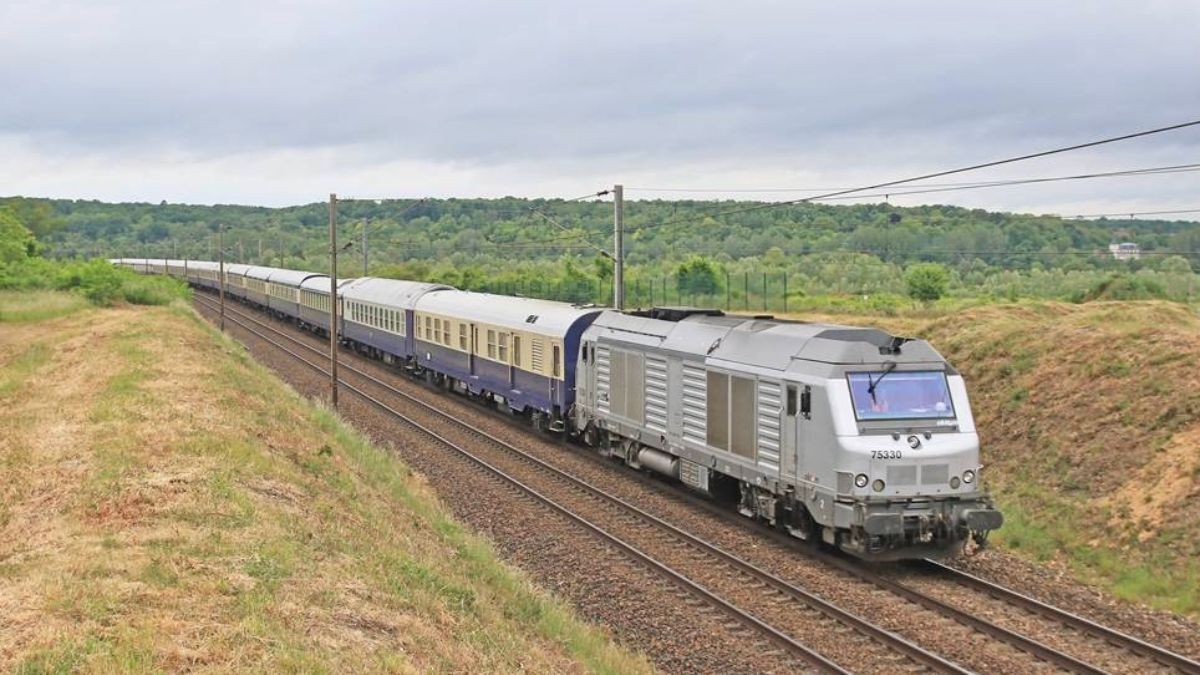
On the 24/25 May the Golden Eagle Danube Express visited France for the first time, offering a luxury 8-day/7-night journey from Paris to Istanbul. Part of a British owned company founded in 1989 as GW Trains offering luxury travel across Central and Eastern Europe and Asia, this set of rolling stock is based in Hungary. Further information via this link. With the war in Ukraine operations are now moving to Western Europe. Seen above at Changis-sur-Marne (77) powered by Akiem BB 75330.
Photo: Christophe Masse.
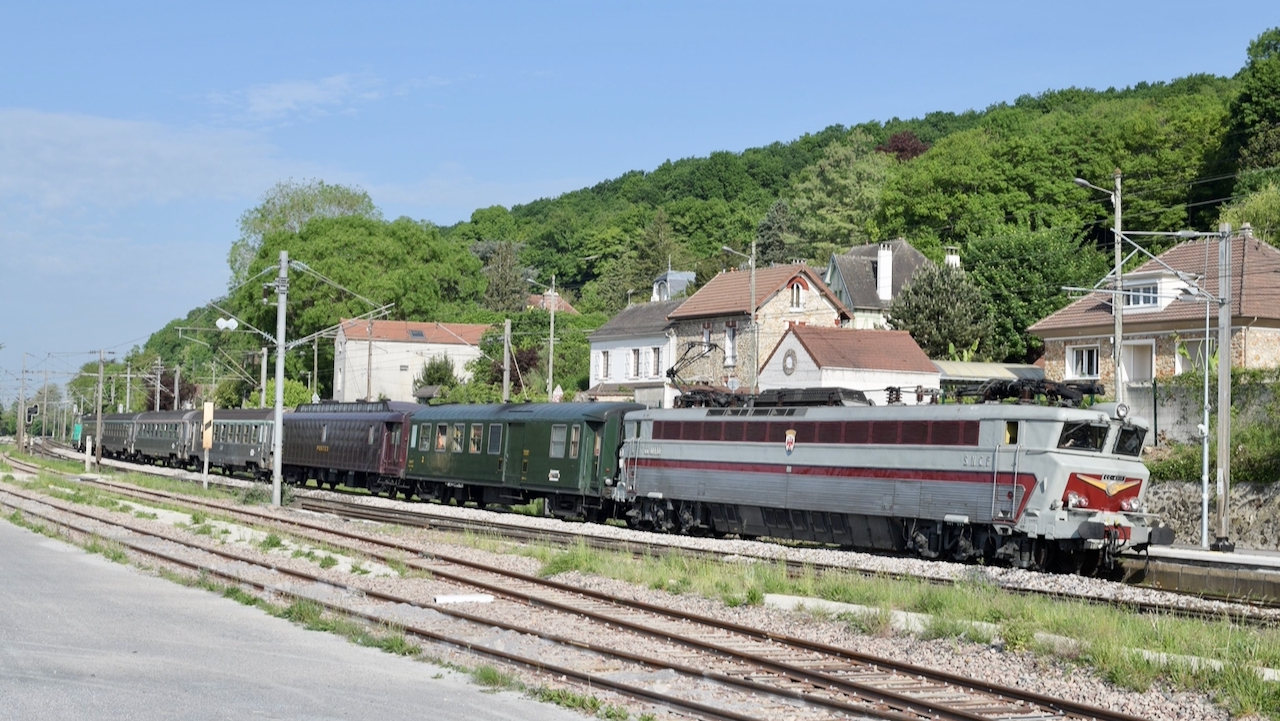
CC 40110 is seen passing through La Ferté-sous-Jouarre on 3 May with MFPN's 'Champagne Express' from Paris to Reims. CC 40110's trip from Paris to Deauville on 24 May was handled by BB 69432 due to pantograph problems. The trip to Dijon on 7 June has been postponed until 2026, as the class has never worked to Dijon and there are clearance issues to be considered. Photo: Jean-Louis Poggi.
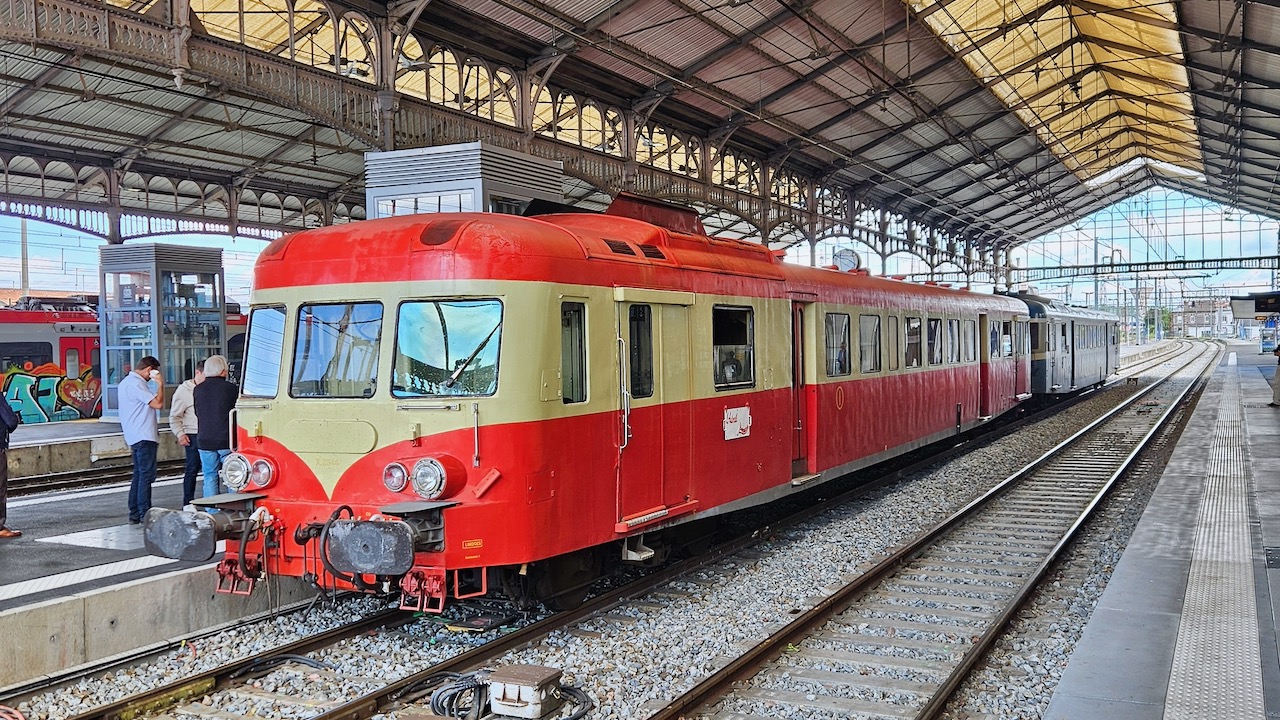
Well away from their home territory, Autorail Limousin's Massif Central autorails X 2844 and X 2907 take a lunchtime break at Tarbes on 12 May, on the final stage of a charter trip from Limoges (07.44) to Lourdes (14.27) for religious group Les Amis d’Arliquet. Photo: Chris Bushell.
The pair returned to Limoges on 14 May and are seen opposite passing Pompignan, north of Toulouse, with X 2907 in the lead.
Photo: Georges Turpin..

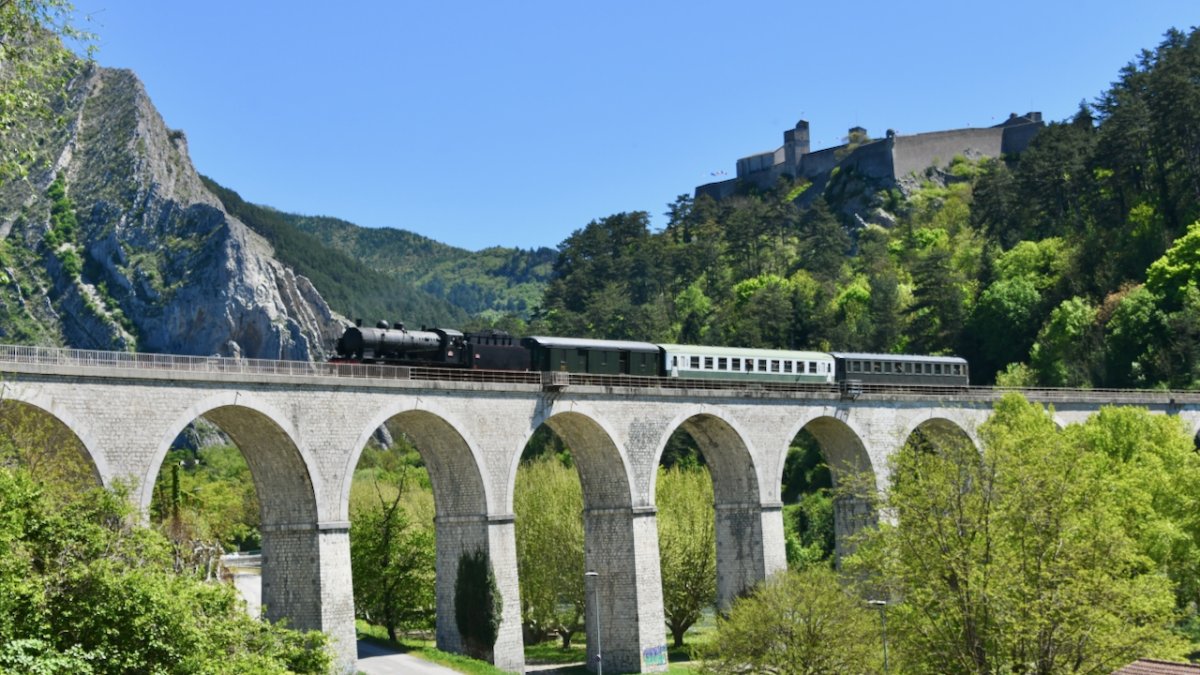
140 C 27 in the Hautes-Alpes

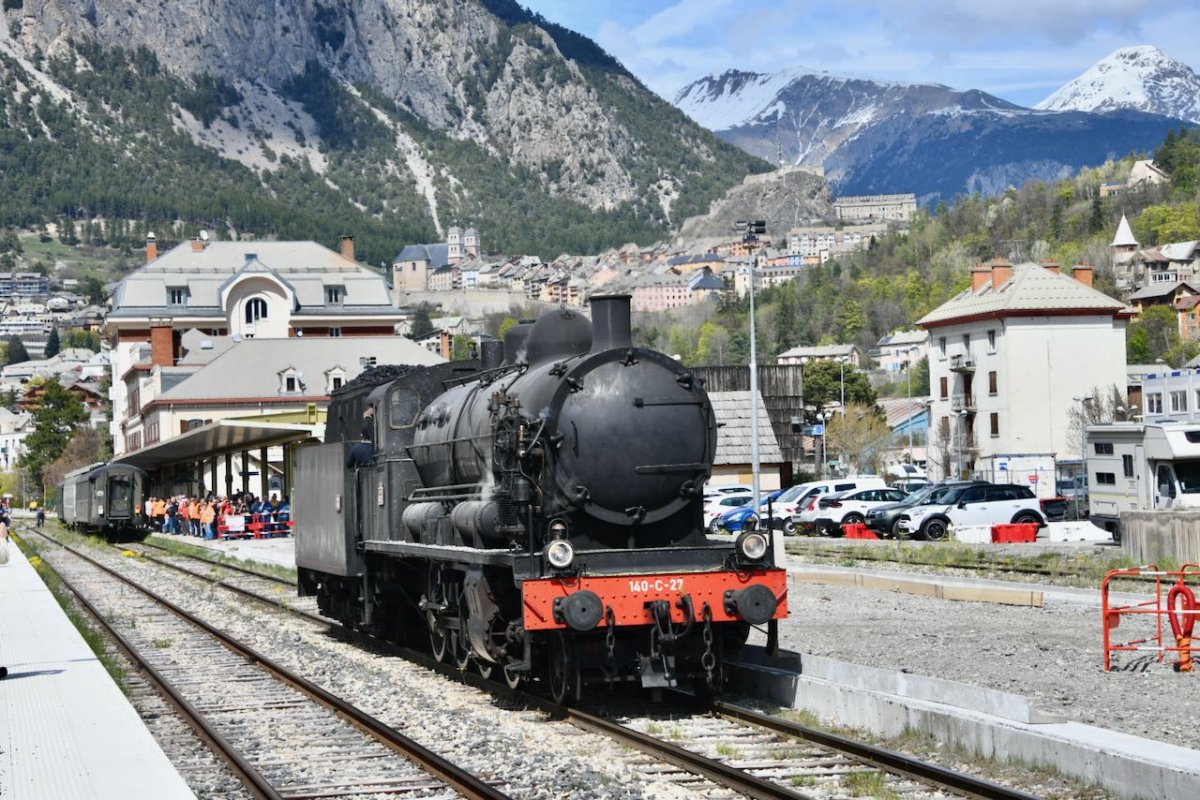
To celebrate the 150th anniversary of the Ligne des Hautes Alpes and the Veynes Rail Festival, 140 C 27 undertook a railtour from Nîmes to Briançon over 25 - 27 April. On the 25th 140 C 27 travelled from Nîmes to Veynes including the Cavaillon – Pertuis freight line. Seen top crossing the 208m viaduct over the river Buëch by the citadel at Sisteron. On the 26th the tour continued from Veynes to Briançon and return, Seen above being turned at Briançon depot, and then reversing into the station, and below, near Embrun crossing the 182m Bramaffan viaduct on the outward journey. Photos: Didier Delattre.
140 C 27 was the first steam locomotive to arrive at Briançon, France's highest city, since 141 R 1187 in July 1975. A video of the event is available via this link and that of 141 R 1187 in 1975 is available via this link. 141 R 1197 is now preserved at Mulhouse.
On 18 May 140 C 27 travelled from Béziers to Clermont-Ferrand where it will spend the summer. It worked to La Bourboule on 31 May, with future trips planned to Langogne (22 June), Nevers & Corbigny (12-14 July), Bellenave (23 August), and Murat (21 September), before returning to Nîmes on the 4 October.
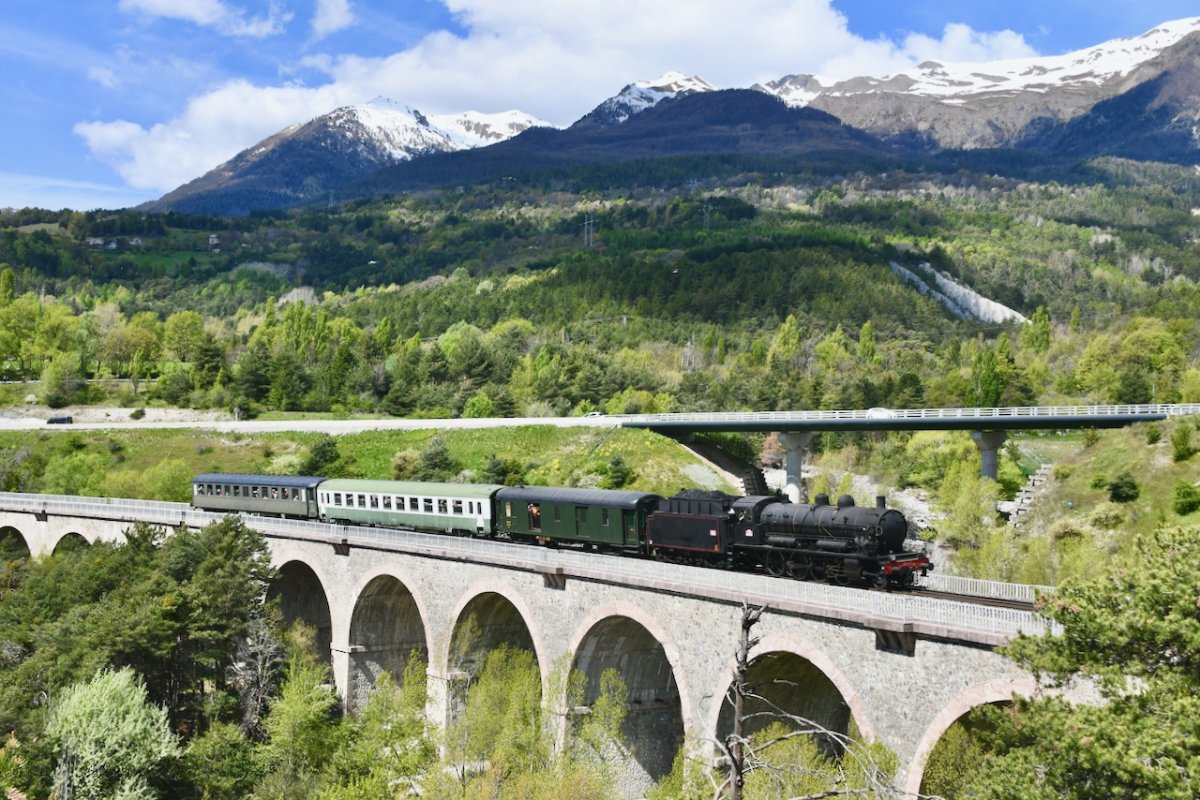
Paris summer works
This year sees more disruption than usual as no engineering work was done last summer on account of the Olympic Games. Expenditure of €3.7 billion has been allocated for 2025 as the network gears up for widespread introduction of new-generation trains on metro and RER, and for opening at the end of next year of Line 15 Sud, the first section of Grand Paris Express. The sum comprises €2 billion for SNCF Réseau, €1.3 billion for RATP and €360 million from ÎdeFM’s 2023-27 budget of €1.8 billion.
Partial or complete closures will affect metro Lines 3, 3bis, 7, 7bis, 8, 10, 12 and 13, where works continue in preparation for arrival of MF19 trains, and on Lines 6 and 9 where Octys train control is being installed. On Line 3, new cleaning facilities are being provided at Galleini and additional storage sidings at Gambetta. Tram T2’s Porte de Versailles terminus is closed until February for rebuilding.
RER B, D and E are seeing major track and infrastructure works, while complete modernisation of RER C is in progress. New catenary is being installed between Choisy-le-Roi and Athis-Mons, extensive tunnel reinforcement works in central Paris, and 5km of track replaced between Austerlitz and Javel.
On RER B and D, the third and final stage of replacing the Pont des Cathédrals (Pont 1 Saint-Denis, see December 2024 News) starts with dismantling of the old bridge over the weekend of 12/14 July, followed by tracklaying on the new structure, erection of OHL and installation of signalling. After another closure from 15 to 17 August, the new bridge will be ready for service.
The other major bridge replacement job is the 1868 Pont des Souverains outside Gare Saint-Lazare where 13 tracks including Lines J and L are carried over boulevard Berthier, T3b and RER Line C. New decking is being installed from below, accessed from the Line C underpass. To minimise disruption, work is being carried out in several phases, by groups of tracks, so that Lines J and L can continue running, albeit with delays. A two-week closure at the beginning of August will complete the task.
Work on rebuilding the Pont des Souverains started at the end of April; RER Line C passes below. Photo: ©RadioFrance/TE.
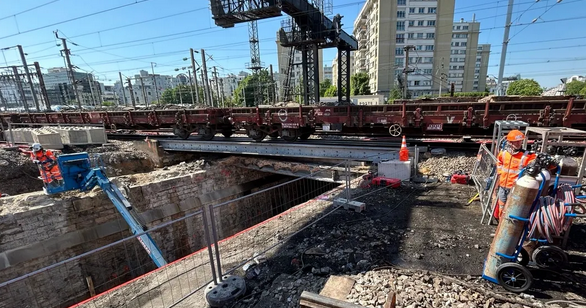
Full details of this summer’s work can be seen at: https://presse.iledefrance-mobilites.fr/download/?zip=2&pictures=31833-31830
Stations for Europe’s largest business quarter

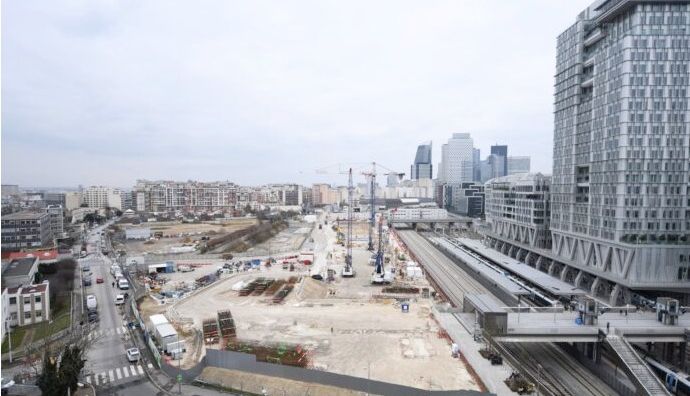
The Line 15 worksite at Nanterre-la-Folie, looking towards La Défénse. The station opened last year on RER Line E’s westwards extension is visible on the right. Photo: Defense-92.fr.
The Line 15 platforms at La Défense will be located in an extremely congested area beneath an access ramp to the A14 road tunnel at a depth of 36.5m. Public entrance will be from a square in the Rose de Cherbourg development. Before full-scale construction can start, contractors are rushing to complete new passageways and ducting to replace existing aircon and water supplies inadequate for the expanded station.
At Nanterre-la-Folie, the 28m wide station box will lie adjacent to the new RER Line E platforms at a depth of 20m, accessed from ground level through a future tower block. Links to the Line E platforms will be provided by a wide underground passageway. Several stabling sidings will be laid in a stub tunnel parallel to the line from La Défense. Tunnelling towards La Défense will begin later this year, the same machine then being utilised to bore in the other direction to Reuil-Suresnes Mont-Valérien. Line 15 Ouest should be operational by 2031, completing the entire 75km circular route with 36 stations.
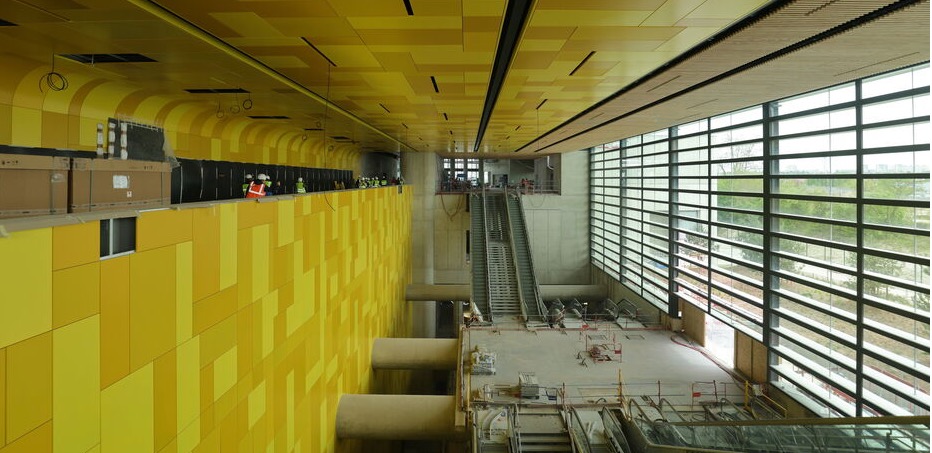

Villiers-Champigny-Bry station (left) is expected to handle 55,000 passengers a day. At Champigny depot (right) Alstom’s MR6V six-car trains are being readied for running trials as they are delivered. Photos: Le Parisien/OA.
This section of Line 15 was scheduled to be the first part of GPE to open, in late 2026, but Société des Grands Projets said on 22 May it was possible that Line 18 between Massy-Palaiseau and Christ de Saclay might open a few weeks earlier.
Urban rail - News In brief
Paris. Metro ridership grew by 68 million journeys (4.8%) to 1,480 million in 2024, driven by the Olympic Games effect and opening of network extensions. Despite the increase, patronage was 105 million lower than pre-covid (2019). Tram journeys rose by 3.2% and RER traffic was up 4.1%, both just below 2019 levels.
ÎdFM has earmarked €5.5 million for recruitment and training of new metro and RER drivers this year, with the aim of augmenting capacity at particularly busy times, such as during major sports events. Staff welcomed an agreement signed on 6 May between RATP and ÎdFM for housing development on surplus land, 40% of which will be ‘affordable’ and reserved for RATP personnel. A former bus depot at Championnet (18th arr) will be replaced by 400 homes, with 450 to be built on part of the Ateliers d’Italie Line 6 metro workshops. Because of the high cost of Paris property, more than half RATP’s personnel live 20km from their workplace and 20% up to 40km away.
Opening of the T1 extension from Noisy-le-Sec to Rue de Rosny Montreuil has been put back a year due to problems with land acquisition, utilities diversion and delay in adoption of the 2023-27 State/Région Contract-Plan. Mid-2028 is now the projected completion date.
Paradise cost. A woman fined €150 for carrying a ‘dangerous’ Bird of Paradise plant on the metro was reimbursed after her complaint went viral on X. RATP agreed that staff had been heavy-handed but reminded travellers that packages over 75cm long must only be 25 x 25cm in other dimensions.
Akha axed. The Akha public transport app, downloaded 130,000 times, has been closed and its creator convicted of ‘facilitating fraud’. The app allowed users to share information on metro delays, security alerts such as pickpocketing, and also the presence of ticket inspectors, contrary to ÎdFM bylaws. Damages have been levied for each operator, with ÎdeFM receiving €20,000.
Strasbourg. The Tram Ouest extension to Wolfisheim is now expected to be ready for trial running by the end of September, with start of public service scheduled to coincide with opening of the Christmas market on 27 November.
Lille. Alstom’s long-delayed 52m trains for Line 1 started trials at the beginning of May, running empty overnight between Quatre Cantons and Hôtel de Ville. On 15 May an undisclosed computer incident led to shutdown of Line 1 for 48h. Two further breakdowns occurred on 24 May, leading to complete closure of the metro at 20.30. There were chaotic scenes in the city centre as replacement buses failed to cope with crowds of up to 60,000 leaving a Bruce Springsteen concert and Gay Pride revellers. Metro service resumed at 00.30.
Rennes. Line B is still suffering fail-safe shutdown incidents caused by premature wear to elastomer membranes enclosing the guide wheels, a problem (unrelated to last year’s closure) that was identified before the line’s delayed opening in 2022. On 2 May, trains were halted for 90min and passengers evacuated. Operator Keolis says it is ‘working with Siemens’ to resolve the trouble.
Toulouse. First results have been published from public consultation on Toulouse’s ‘Mobility Tomorrow’. These will help define a roadmap for development of the city’s public transport through to 2040, when population is expected to have grown 20% to 1.3 million. Contributions from the 3,000-or-so participants will inform the next phase, due in a year’s time, which will specify major projects to follow completion of metro Line C. ‘Above all, people want more public transport’ was the message. Development of the SERM network is likely to take centre stage, with metro and tramway extensions under consideration as well as express bus routes, especially to areas poorly-served. There will be greater emphasis on walking and cycling.
Montpellier. A trial run on Line 5 on 19 May was disrupted by a power failure, but two days later trams ran over the entire route for the first time. Public service is due to start on 20 December.
Additions to FRS Photographic Archive during May 2025
To Photographic section
To Locations section
Additions to the FRS public folder during May 2025
- Added FACS 422/March-April 2024 to Folder 12
- Re-organised the 'Michael Bunn' collection in Folder 1 and added images to various sub-galleries
- Added a 'Peter Clegg' gallery to Folder 1
- Added some drawings to Folder 2 (in 'Nord” & “Miscellaneous')
- Added SNCF brochure 1979 'Wagons à Marchandises' to Folder 4
To Locations section
- Added LVDR 488/1954 'Diesel Traction'
- Added LVDR 1932/Dec 1983 'Saône-et-Loire'
Additions to the FRS public folder during May 2025
- A selection of images depicting PO voitures from 1840 thru to 1877
- A summary of railway equipment displayed at the Paris Exhibition 1900 together with floorplans of the exhibits at both Champ-de-Mars and Vincennes
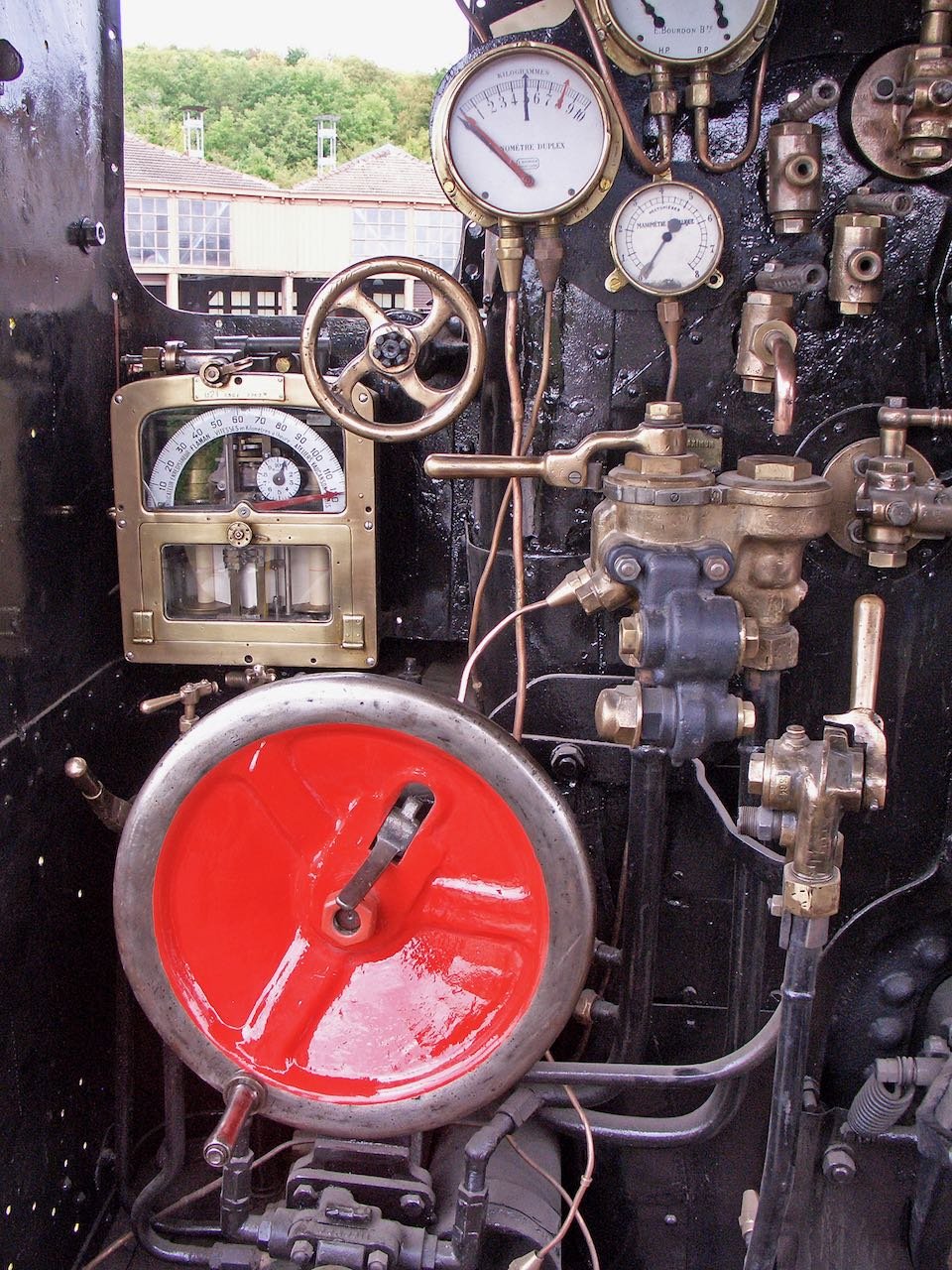
© Peter Lovell & Chris Bushell. The French Railways Society 2025. With thanks to Georges Turpin, Christophe Masse, Didier Delattre, Jean-Louis Poggi and Pierre Julien.
